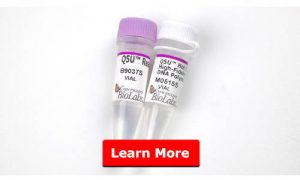What is DNA Polymerase and its function?
DNA polymerase is a type of enzyme that can be found in every cell. Its main function is to replicate new DNA strands from an original DNA strand. In other words, after replication, there will be two new daughter DNA strands, which carry the same genetic information with the original DNA strand.
During the replication, the DNA polymerase always pairs Adenine with Thymine and pairs Cytosine with Guanine, in the 5’-3’ direction of the DNA strand. This is because it only can add nucleotide onto the free 3’-OH group of existing DNA strand.
Well, nothing is perfect in this world, DNA polymerase would make a mistake as well. It might pair the wrong nucleotide to the parent strand. However, for some polymerases, they have the error correction mechanisms, also known as proofread. In proofreading, the DNA pol reads the newly added base before adding the next one. If incorrect, the enzyme makes a cut at the phosphodiester bond and releases the wrong nucleotide. This is performed by the exonuclease action of the polymerase.
DNA polymerase is useful for many applications, including polymerase chain reaction (PCR), cloning, single-nucleotide polymorphism (SNP), etc. To ensure that the DNA polymerase is performing at its best for different applications, NEB has developed a series of DNA Polymerase which is optimized for different application.
Comparison of different type of DNA polymerase from NEB
NEB has a series of DNA polymerase that suitable for different users’ applications. Here, we’ll discuss some of them, including Q5® and Q5®U, Phusion® and OneTaq.
What is Q5® high-fidelity DNA polymerase?
Q5® high-fidelity DNA polymerase is famous for its fidelity and robust performance. This is due to it is composed of a novel polymerase which is fused to the processivity-enhancing Sso7d DNA binding domain.
Up to date, Q5® has the highest fidelity amplification (~280 times higher than Taq) and hence has an ultra-low error rate. As a result, it is ideal for molecular cloning and can be used for long or difficult amplicons.
What are the advantages of using Q5®?
Q5® is suitable for all PCR applications and a wide variety of target. This includes high AT to high GC amplicons, and up to 10kb of human genomic amplicons (for simple genomic amplicons: at least 20kb).
What are the applications of using Q5®?
The applications include:
- Ultra high-fidelity PCR
- Long-range PCR
- Cloning from in vitro material for protein expression or gene analysis
- SNP analysis via cloning and sequencing
- Site-directed mutagenesis
- NGS Library prep

Learn more about Q5®
What is Q5U® Hot Start High-Fidelity DNA Polymerase?
If you are working with uracil-containing DNA templates or using dUTP, you are recommended to use the new Q5U® Hot Start High-Fidelity DNA Polymerase. What’s so special about the Q5U®? Q5U® has the ability to read and amplify templates containing uracil and inosine bases. This is because Q5U® contains a mutation in the uracil-binding pocket. Moreover, you can prevent carryover contamination when combined with dUTP and Uracil DNA Glycosylase (UDG) treatment.
What are the advantages of using Q5U®?
- Achieve superior amplification of bisulfite-converted, deaminated, or damaged DNA (e.g., FFPE)
- Prevent carryover contamination when combined with dUTP and Uracil DNA Glycosylase (UDG) treatment
- Generate higher assembly efficiency and improve accuracy in USER® cloning
- Enable room temperature setup with aptamer-based hot start formulation
What is the application of Q5U®?
The application includes:
- USER cloning
- High fidelity amplification of bisulfite converted or deaminated DNA substrates
- Carryover prevention

Learn more about Q5U®.
What is OneTaq® DNA Polymerase?
OneTaq® DNA Polymerase is the fusion of Taq and Deep Vent® DNA polymerase that suitable for most PCR application. OneTaq® is 2x higher fidelity than Taq. As a result, it has a lower error rate compared to Taq.
Tips: Did you know most OneTaq reactions amplify more efficiently and robustly when you use a 68°C extension temperature?
What are the advantages of using OneTaq®?
- 2x higher fidelity than Taq
- Ideal for routine, AT- and GC- rich PCR
What are the applications of using OneTaq®?
- High Sensitivity PCR
- High Throughput PCR
- Routine PCR
- GC-rich PCR
- AT-rich PCR
- Colony PCR
- Long PCR (up to ~6 kb genomic)

Learn more about OneTaq®
| Product | Fidelity | dU Tolerance | Resulting Ends | Applications |
| Q5® | 280x Taq | No | Blunt | Ultra high-fidelity PCR, long-range PCR, cloning from in vitro material for protein expression or gene analysis, SNP analysis via cloning and sequencing, site-directed mutagenesis, NGS Library Prep |
| Q5U® | 280x Taq | Yes | Blunt | USER cloning, high fidelity amplification of bisulfite converted or deaminated DNA substrates, carryover prevention |
| OneTaq® | 2x Taq | No | Mixture | Routine PCR, colony PCR, genotype screening |
| Taq® | Taq | No | A-tailed | Routine PCR, Multiplex endpoint PCRW |




Hello, constantly i used to check website posts here in the
early hours in the morning, as i enjoy to find out more and more.
Hey Dominoqq, thanks! Hope you could enjoy more and more on our website!